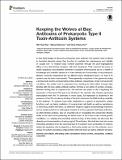Por favor, use este identificador para citar o enlazar a este item:
http://hdl.handle.net/10261/152949COMPARTIR / EXPORTAR:
 SHARE SHARE
 CORE
BASE CORE
BASE
|
|
| Visualizar otros formatos: MARC | Dublin Core | RDF | ORE | MODS | METS | DIDL | DATACITE | |

| Título: | Keeping the Wolves at Bay: Antitoxins of Prokaryotic Type II Toxin-Antitoxin Systems |
Autor: | Chan, Wai Ting CSIC; Espinosa, Manuel CSIC ORCID ; Yeo, Chew Chieng | Fecha de publicación: | 22-mar-2016 | Editor: | Frontiers Media | Citación: | Frontiers in Molecular Biosciences 3: 9 (2016) | Resumen: | In their initial stages of discovery, prokaryotic toxin-antitoxin (TA) systems were confined to bacterial plasmids where they function to mediate the maintenance and stability of usually low- to medium-copy number plasmids through the post-segregational killing of any plasmid-free daughter cells that developed. Their eventual discovery as nearly ubiquitous and repetitive elements in bacterial chromosomes led to a wealth of knowledge and scientific debate as to their diversity and functionality in the prokaryotic lifestyle. Currently categorized into six different types designated types I–VI, type II TA systems are the best characterized. These generally comprised of two genes encoding a proteic toxin and its corresponding proteic antitoxin, respectively. Under normal growth conditions, the stable toxin is prevented from exerting its lethal effect through tight binding with the less stable antitoxin partner, forming a non-lethal TA protein complex. Besides binding with its cognate toxin, the antitoxin also plays a role in regulating the expression of the type II TA operon by binding to the operator site, thereby repressing transcription from the TA promoter. In most cases, full repression is observed in the presence of the TA complex as binding of the toxin enhances the DNA binding capability of the antitoxin. TA systems have been implicated in a gamut of prokaryotic cellular functions such as being mediators of programmed cell death as well as persistence or dormancy, biofilm formation, as defensive weapons against bacteriophage infections and as virulence factors in pathogenic bacteria. It is thus apparent that these antitoxins, as DNA-binding proteins, play an essential role in modulating the prokaryotic lifestyle whilst at the same time preventing the lethal action of the toxins under normal growth conditions, i.e., keeping the proverbial wolves at bay. In this review, we will cover the diversity and characteristics of various type II TA antitoxins. We shall also look into some interesting deviations from the canonical type II TA systems such as tripartite TA systems where the regulatory role is played by a third party protein and not the antitoxin, and a unique TA system encoding a single protein with both toxin as well as antitoxin domains. | Versión del editor: | http://dx.doi.org/10.3389/fmolb.2016.00009 | URI: | http://hdl.handle.net/10261/152949 | DOI: | 10.3389/fmolb.2016.00009 | ISSN: | 2296-889X |
| Aparece en las colecciones: | (CIB) Artículos |
Ficheros en este ítem:
| Fichero | Descripción | Tamaño | Formato | |
|---|---|---|---|---|
| Keeping the Wolves at Bay.pdf | 2,77 MB | Adobe PDF |  Visualizar/Abrir |
CORE Recommender
PubMed Central
Citations
69
checked on 05-abr-2024
SCOPUSTM
Citations
108
checked on 11-abr-2024
WEB OF SCIENCETM
Citations
100
checked on 22-feb-2024
Page view(s)
257
checked on 17-abr-2024
Download(s)
246
checked on 17-abr-2024

